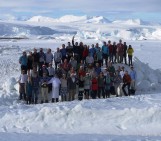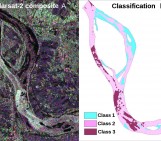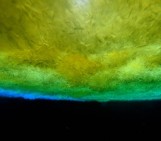
When you go down to the woods today you’re in for a big surprise….. hair ice!
Did you know that there is a type of ice called hair ice? It is shaped like fine, silky hairs and looks like white candy floss. It grows on the rotten branches of broad-leaf trees during humid winter nights when the air temperature drops slightly below 0°C. A 100-year-old theory states that hair ice also needs something else to grow – a fungus – but, until recently, no one had managed to confirm this.
A team of scientists (a physicist, a chemist and a biologist) in Germany and Switzerland have now identified the missing ingredient – the fungus Exidiopsis effusa – after performing a series of experiments (Hofmann et al, 2015).
The biologist, Gisela Preuß, studied samples of hair-ice wood under the microscope and discovered that all of them were home to Exidiopsis effusa. If the fungus was missing or its activity stopped by fungicide or hot water, the hair ice would be missing too. The physicist, Christian Mätzler, studied the physical mechanism that makes hair ice grow in such fine strands. He discovered that the shape of the ice is due to the internal structure (rays) of the wood and growth of the fungus, which together prevent the ice from forming large crystals at the wood surface. The chemist, Diana Hofmann, studied the hair ice itself and identified natural substances produced by the fungus – lignin and tannin – that allow the hair ice to keep its hairy shape for a long time. This collaboration between scientists from different fields really shows the power of putting your heads together!
It took 100 years to confirm the theory because hair ice is rare and hard to spot: it mostly forms during the night, melting when the sun rises.
So…keep an eye out next time you go for an early morning walk in the woods. If you can find hair ice, you are in for a treat!
Reference/further reading
 This is modified version of a “planet press” article written by Bárbara Ferreira and originally published on 22 July 2015 on the EGU website
This is modified version of a “planet press” article written by Bárbara Ferreira and originally published on 22 July 2015 on the EGU website
(Hungarian, Portuguese, Serbian and Spanish versions are also available, why not considering adding a new language to the list? 🙂 )
- Hofmann, D., Preuss, G., and Mätzler, C.: Evidence for biological shaping of hair ice, Biogeosciences, 12, 4261-4273, doi:10.5194/bg-12-4261-2015, 2015.
- A longer version of this article exists on the EGU website : ‘Press Release: Fungus shapes hair ice – Researchers identify fungus responsible for peculiar ice filaments that grow on dead wood‘.





Mitko
They look really nice. Is there something similar in Lake Baikal? Any info about it?
Pingback: Cryospheric Sciences | Image of the Week – The mystery of the ice mushrooms